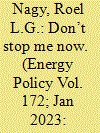|
|
|
Sort Order |
|
|
|
Items / Page
|
|
|
|
|
|
|
| Srl | Item |
| 1 |
ID:
183598


|
|
|
|
|
| Summary/Abstract |
To meet Canada's emissions reduction targets, governments at the federal and provincial levels have developed climate plans and implemented a series of policies and regulations. Canada's latest climate plan, entitled “A Healthy Environment and a Healthy Economy” aims to decarbonize various sectors of the economy including the electricity sector. In this paper, we explore the extent to which implementing announced policies and regulations could drive investment in the electricity sector needed to achieve Canada's climate objectives. To do so, we propose a multi-period, optimization-based capacity expansion model specifically designed for the Canadian context entitled COPPER for the “Canadian Opportunities for Planning and Production of Electricity Resources.” We employ COPPER to analyze Canada's electricity system transition under various carbon management policies. Results show that current and announced policies significantly increase renewable energy capacity, which in turn decrease the electricity system emissions by 40 percent in the mid-term. However, in the long-term, more ambitious actions will be required to achieve the emissions reduction targets. Natural gas-powered generation facilities persist at the proposed carbon tax levels, and thus supplementary regulations or policies will be needed to achieve deep decarbonization.
|
|
|
|
|
|
|
|
|
|
|
|
|
|
|
|
| 2 |
ID:
188571


|
|
|
|
|
| Summary/Abstract |
Once a subsidy scheme is close to reaching its goal or loses political support, it may be terminated. An important question for policy makers is how to minimize the negative impact of the risk of subsidy termination on industrial investment. We assume the social planner aims to increase capacity and welfare and uses a subsidy, which has an uncertain lifetime, for the purpose. We examine a monopolist supplying an uncertain demand, faced with the option to expand capacity by irreversibly investing in small increments. We find that the firm installs capacity expansions sooner and, consequently, installs a larger capacity than a firm without a subsidy. A firm’s total investment during the subsidy’s lifetime increases with both the subsidy size and the likelihood of subsidy withdrawal. However, this happens at the cost of less investment directly after the subsidy has been retracted. The optimal subsidy size strongly depends on the point in time at which the social planner aims to maximize the welfare — the further into the future, the larger the welfare optimal subsidy. Furthermore, the welfare optimal subsidy size strongly depends on the social planner’s discretion over adjustments to the subsidy size.
|
|
|
|
|
|
|
|
|
|
|
|
|
|
|
|
| 3 |
ID:
176118


|
|
|
|
|
| Summary/Abstract |
The petrochemical industry plays a pivotal role in achieving high value-added products from oil and gas reserves. With attention to oil and gas reserves in Iran, it is clear that the petrochemical industry has not grown up adequately. This study aims to determine effective factors on petrochemical industry development and model the mechanism of capacity expansion budget creation using a system dynamics approach. A quantified system dynamics model has been built based on causal relationships and the mechanism of development budget allocation among categorized products. This structure is used to simulate the model and investigate essential variables related to each product, such as production capacity value, production rate, domestic sale revenue, and export. According to the results of a simulation, in 2025, Iran will have a capacity of approximately 104 million tons of petrochemical products that is not desirable. In this study, a policy of improving budget plan and allocation is introduced as the most effective solution to achieve the petrochemical industry development. By implementing this policy the production capacity and total revenue would respectively be improved by 4% and 13% in 2025 in comparison with the base run.
|
|
|
|
|
|
|
|
|
|
|
|
|
|
|
|
| 4 |
ID:
166524


|
|
|
|
|
| Summary/Abstract |
Wind and solar power are predicted to dominate CO2 emission reductions in future electricity systems. Unlike spatially compact fossil fuels, harnessing renewable energy flows increases the land area impact of electricity production. This study quantifies the trade-offs between land area impacts, technology alternatives of decarbonisation pathways, and costs associated with reducing carbon emissions from electricity generation by ~ 90%.
|
|
|
|
|
|
|
|
|
|
|
|
|
|
|
|
|
|
|
|
|